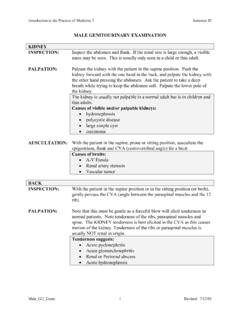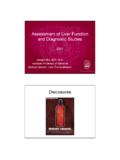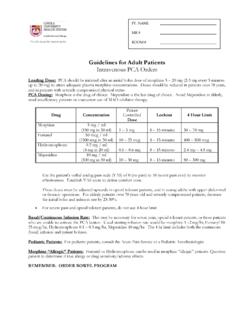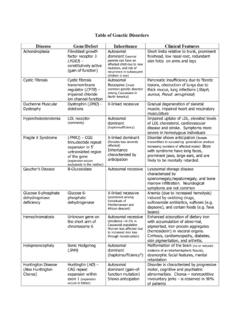Transcription of Neurologic Exam Evaluation Checklist - Stritch …
1 Introduction to the Practice of Medicine 2 Neurologic EXAM DETAILS FROM NEURO EXAM VIDEO WASH HANDS (Patient is seated.) Cranial Nerves: 1. Visual fields (screening test for CN2 & Visual system: peripheral vision) A. Examiner is positioned: a. in front of patient b. about 2 feet away from patient c. at eye level with the patient B. Examiner instructs patient to stare at examiner s nose ( Don t move your eyes. ) C. Examiner stares at patient s nose D. Both eyes are examined together (Both eyes are open) a. Examiner holds out his or her index fingers in the periphery of the patient s vision, about 180o apart ( , above the patient s right eye and below the patient s left eye), and slightly wiggles one index finger at a time. b. The patient is asked to identify or point to the moving finger.
2 C. With the examiner s fingers in the same position as in (a), both fingers are wiggled at the same time, and the patient should identify that both are simultaneously moving. d. Examiner then rotates his or her extended index fingers about 90o from the initial position ( , now above the patient s left eye and below the patient s right eye), and slightly wiggles one index finger at a time. e. With the examiner s fingers in the same position as in (c), both fingers are wiggled at the same time, and the patient should identify that both are simultaneously moving. f. Examiner holds his or her index fingers about 180o apart in the temporal visual fields ( , left of patient s left eye, right of patient s right eye) in a horizontal plane. g. The patient is asked to identify or point to the moving finger. h.
3 With the examiner s fingers in the same position as in (e), both fingers are wiggled at the same time, and the patient should identify that both are simultaneously moving. E. Examiner should have his or her finger half way between the patient and his/herself, and gradually move the wiggling finger more towards the center of vision, until it is perceived by the patient. F. Examiner rotates his or her index fingers, checking for the visual fields of both eyes superiorly, inferiorly and temporally. Any abnormality or problem with this screening test of visual fields, or a complaint of visual loss, prompts retesting of visual fields one eye at a time (see Addendum later). Failure of the patient to recognize both simultaneously moving fingers suggests visual extinction from a parietal lobe lesion. G:\IPM2\2004-05\ - 1 - Revised: 7/22/04 Introduction to the Practice of Medicine 2 Note: The examiner should be testing his/herself at the same time and comparing his/her answer to the patients assuming the examiner has normal visual fields!
4 2. Student inspected both eyes with the ophthalmoscope. (CN2) These are not essential; however doing these optimizes conditions to facilitate the exam: Proper patient position is helpful for ophthalmoscopy A. If the patient is slouching tell them to sit up straight so the examiner doesn t have to bend over to attempt the exam B. If the patient is sitting too far back on the exam table, the examiner might ask patient to sit forward on the table. C. If patient is already in a good position, nothing may need to be changed These are essential (right-right-right, and left-left-left): A. Examiner holds ophthalmoscope with examiner s right hand to look through examiner s right eye when inspecting patient s right eye. B. Examiner holds ophthalmoscope with examiner s left hand to look through examiner s left eye when inspecting patient s left eye.
5 C. Examiner darkens room ( , turn off or down lights, close shades, etc.) a. warn the patient you are going to do this! D. Patient is told to stare off in the distance or stare at the wall (look at the clock on the wall) and not to look at the light from the ophthalmoscope or not to move their eyes during this exam. E. Examiner should stand right next to the patient s mid thigh (you need to be next to the patient) a. You may need to tell patient to put their legs together so you can be close to them F. Hold the ophthalmoscope so that: a. the top of the scope is against your eyebrow b. the bottom of the scope is held against your upper cheek c. examiner s head and the ophthalmoscope should move as one d. common error examiner holds the ophthalmoscope too far from their face G. Examiner should start about 12 to 15 inches from the patient and slowly move forward to the patient s eye.
6 (Examiner should not startle the patient by moving towards the patient too quickly; a brief introductory statement lets the patient know what to expect.) H. Examiner looks approximately 15 degrees lateral to patient s line of vision to see the disc a. common error examiner is directly in patient s line of vision and then can t locate the disc I. Examiner begins about 12-15 inches from patient s eye with the diopters reading at about +8 to +10 (either green or black numbers on ophthalmoscope) to first see the red reflex. While slowly changing the diopters towards 0 or a negative 1 or 2 (red numbers), the examiner approaches the patient to see the optic disc and retina. J. Examiner should systematically inspect: a. Optic disc: color, shape, margins, and cup-to-disc ratio G:\IPM2\2004-05\ - 2 - Revised: 7/22/04 Introduction to the Practice of Medicine 2 b.
7 Vessels: caliber, arterial/venous ratio, obstruction, arterial light reflex, and for presence or absence of arterial/venous nicking. c. Background: inspect for pigmentation, hemorrhages, hard or soft exudates d. Macula: attempt to identify 3. Examiner shined a light into each eye separately (CN2, 3) to assess pupil response A. Right eye B. Left eye (The examiner should check for the direct and consensual response to light in each pupil) 4. Examiner checks for all 6 cardinal positions of gaze (CN3, 4, 6) A. Examiner tells patient to not move their head and Follow my finger with your eyes open. B. Examiner places their finger/penlight/ or other object about 12 inches or more from patient C. Examiner makes a large H; while patient moves his/her eyes from the his/her nose, examiner should: a.
8 Move about 1 foot horizontally from the midline b. then move vertically about 1 foot up and down at that lateral point c. then repeat in the other direction D. The 6 cardinal positions of gaze: LR6, SO4, all the rest 3 i. lateral rectus muscle for lateral gaze = CN6 = abducens verve ii. superior oblique muscle for gaze down and in = CN4 = trochlear nerve a. lateral gaze: lateral rectus muscle = CN6 (abducens) b. medial gaze: medial rectus muscle = CN3(oculomotor) c. gaze up and out: superior rectus muscle = CN3 d. gaze down and in: superior oblique muscle = CN4 (trochlear) e. gaze up and in: inferior oblique muscle = CN3 f. gaze down and out: inferior rectus muscle = CN3 5. Examiner assessed light touch on patient s face (3 sensory divisions of CN5) A. Examiner explains step to patient first B.
9 Examiner tells patient to close their eyes C. Examiner uses a fine wisp of cotton and asking patient to respond each time they feel the touch D. SIX AREAS MUST BE ASSESSED a. both sides of the forehead (ophthalmic division of CN5) b. both sides superficial to maxillary sinuses = cheeks (maxillary division of CN5) c. both sides superficial to the mandibles = jaw (mandibular division of CN5) 6. Examiner asked patient to raise both eyebrows or to frown or wrinkle my forehead. (CN7) Examiner may demonstrate the desired result to the patient first 7. Examiner asked patient to show my teeth or smile and show your teeth (CN7) Examiner may demonstrate the desired result G:\IPM2\2004-05\ - 3 - Revised: 7/22/04 Introduction to the Practice of Medicine 2 8. Examiner asked patient to close his/her eyes and identify the examiner s gentle rubbing of his/her fingers (or ticking watch or whispered word) about 3 inches from right and left ear.
10 (Auditory division, CN8) 9. Examiner asks patient to say ah. Both sides of the palatal arch and the uvula should elevate symmetrically. (CN10, questionably CN9) The gag elicited by the palatal reflex is annoying to some patients, so this reflex should be checked only if palatal elevation upon saying ah appears abnormal, or the patient has complained of a problem with swallowing or speech. The peritonsillar area on each side is gently touched with a cotton swab (afferent is CN9) and symmetrical elevation of the palate and uvula occurs (efferent is CN10). It is doubtful that CN9 has any motor function regarding the palate, but it does supply sensory input for the gag (palatal) reflex. 10. Examiner asks patient to cough. (CN10, Vagus nerve, innervates the vocal cords) Examiner may ask patient to turn their head so the patient does not cough on the examiner.







![WOUND HEALING lecture.ppt [Read-Only]](/cache/preview/2/b/6/c/1/4/7/f/thumb-2b6c147f08025508ccf4ec201274f3ba.jpg)

